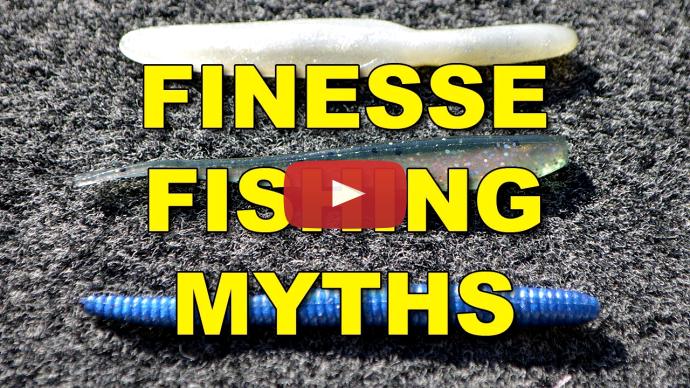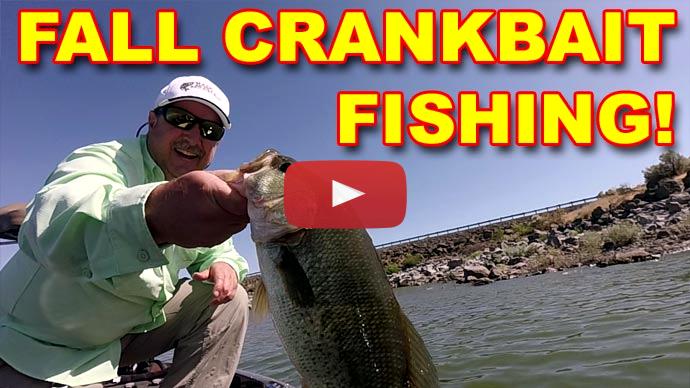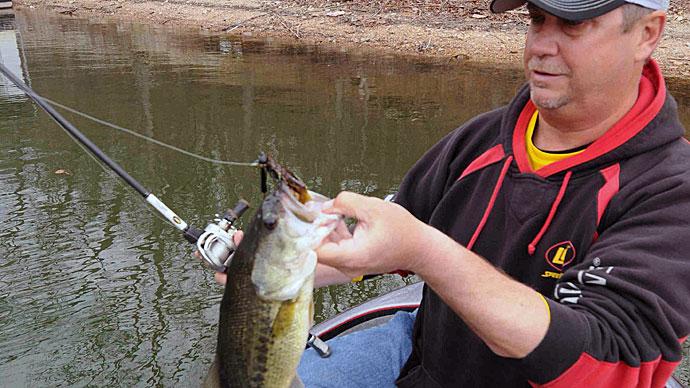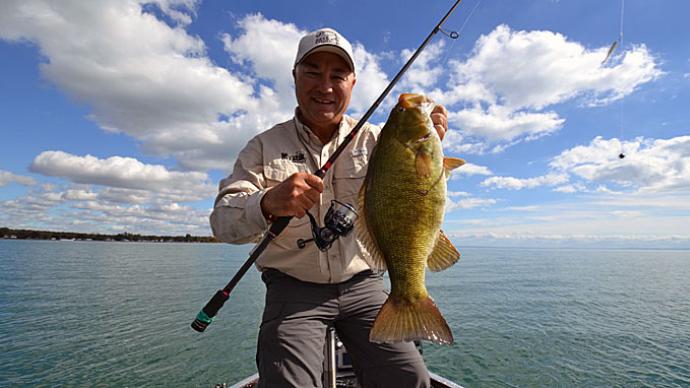Glenn: That is a fish.
Woman: There you go.
Glenn: Boy, that was just a light pick-up.
Woman: Woo-hoo.
Glenn: A real light pick-up.
Woman: Another mad…. That's a smallie.
Glenn: That's a smallie there. It's a good smallie.
Woman: He's a little football.
Glenn: Football in the fall. We're catching footballs in the fall with finesse jigs. Fantastic! Fabulous!
Hey, folks, Glenn May here with BassResource.com. Today I wanna talk to you about finesse jig fishing in the fall. Finesse jigs can be dynamite in the fall, because the bass are feeding up on bait fish, and a little finesse jig like this is about bait fish size. So the bass'll just feed up on this thing. This is what we're talking about, these guys right here. Okay, this is just a quarter ounce finesse jig. I wanna talk about, kinda, how I rig up, what kind of a gear I'm using, and then the different places and ways to fish this during the fall to catch the most bass during this time of year.
So, first of all, I'm using...this is a finesse-type technique, so I'm using spinning outfit. Don't know if you guys don't like spinning gear, but you're gonna have to learn how to use it if you wanna get the best out of it. This is the reason why. First of all, this bait has got a thin wire hook on it. And when you've got thin wire hooks, you don't wanna get too heavy on them, because if all the gear you're using is heavy duty, you can do two things. One, you can either bend the hook out a little bit, and you can lose the fish, or you can literally rip the hook right out of the fish's mouth. Because that wire is so thin it doesn't have a big bite to it. You can lose a fish that way. So you need equipment that's all matched.
So, starting with the line, I'm using 6.2 pound Seaguar Fluorocarbon Finesse fishing line. Yeah, 6.2. The reason being, first of all, you know, Seaguar is the ones...they invented fluorocarbon line, in case you didn't know that, and so they manufacture everything their own. The resin they use, the fluorocarbon resin, is designed specifically for finesse line, fluorocarbon line, and nobody else does that. And then the whole manufacturing process, they do it themselves. So, they're in control, quality control, end-to-end production. That's why they can make 6.2 pound, and nobody else can. It's super light, super sensitive, really strong for its test strength, real abrasion-resistant. And I like it because it's very supple. There's really no memory on it at all. And because of that, it helps casting, you wanna cast this a long distance. Plus, the sensitivity of it, you know, this is a finesse technique, a lot of the bites are very, very subtle. And the finesse line really helps you...that fluorocarbon line helps you feel that bite. If you're using braid, for example, braid is a little buoyant, whereas fluorocarbon is denser, so braid has this bend in the line, so you don't have as direct a connection to the bait. Plus, braid is not forgiving at all. It has no stretch whatsoever. And, again, you've got this thin wire hook, braid's gonna do all the bad things to that hook that you don't want to happen, or you're gonna rip the hook right out of the fish's mouth. So, fluorocarbon is it.
I don't use leaders or anything like that. Just because you put a 2 or 3-foot leader on there doesn't mean you've erased all those negative attributes of braid. It doesn't work that way, guys. The stretch on fluorocarbon is a bit overrated, it doesn't stretch that much, but you need a lot of line out to have that kind of stretch. And that's what you want to absorb the shock of the fish as you're fighting it back to the boat.
And here we're using a 7-foot medium light power moderate action rod. So it's going to give and bend as the fish is fighting back to the boat. It won't rip that hook out. So you need that kind of give, the springy kind of action is what you want, in order to handle a big fish.
And then the spinning gear, you're not really...it doesn't matter if you're using a super high-speed reel, you don't need that. Anywhere between a six and seven and a half to one gear ratio is fine, but spinning, you know, the drag washers are here in the face of it, which means it's got a bigger surface area. So the drag by nature is actually smoother, and that's real critical when you're fishing this kind of stuff, is that real nice smooth drag. So when the fish makes those really hard runs, it's gonna play out, and you're gonna keep that hook stuck in that fish. So it all works together in concert when you're fishing these finesse jigs. So that's the gear I'm using. That's how I got it all hooked up. Now, let's go out and fish it.
There's another one. Look at that.
Woman: Awesome.
Glenn: This is ridiculous fishing.
Woman: But we like it.
Glenn: These fish love this finesse jig.
Woman: Well, they're trying to get fat for the winter.
Glenn: This is another good one.
Woman: It's like, "Crawdad. Crawdad."
Glenn: Look at this. This is another keeper here.
Woman: They're all about the same size, aren't they?
Glenn: I swear I'm not catching the same fish over and over again.
Woman: It does look like it, though, doesn't it?
Glenn: That finesse jig. Here you go, buddy.
So during the fall, the fish can...they roam. They go everywhere. They are chasing baitfish. So they can be on main lake points in the morning, and they can be all the way back to the shallow part of coves in the afternoon, and all points in between, and it's not linear. They might be midway up in a cove in the morning, and then out to the main lake structure in the afternoon, and then all the way up shallow later in the day. So, it's hard to find them. But this little guy will help attract any fish that are in the area, because it looks just like a dying baitfish, which is what they're looking for.
So, what I tend to do is I kind of go through a methodical approach. I start at the entrance to bays and coves that have running water in them, fresh running water. Because the baitfish are looking for oxygen-rich water, and that running water coming in, that fresh water coming into those coves, brings in that oxygen. So if a cove doesn't have any fresh water coming into it, I skip it. I go to the next one. It's not that there won't be any baitfish in there, but there's more baitfish and a greater concentration of bass, therefore, in coves that have fresh running water in it.
So I start in the entrances of those, and main lake points, if there's a hump, a reef, or maybe a creek channel right there in the entrance, I start there. I just throw this out there and let it fall all the way down to the bottom, and then I just...I give it hops, and pretty good hops, especially in the early to mid-fall. This is late summer into mid-fall. As you lift it up, let it fall, and don't let it sit too long, lift it up and let if fall again. And you're lifting it up by, you know, not much. You're lifting it up maybe about a foot or two, maybe 2 feet. Let it just fall back down, and watch that line while it's falling, because a lot of the bites happen while it's falling. So, pay close attention to that line. If it twitches, jumps, jerks, swims off to one side, does anything different that you didn't impart, it's probably because a fish hit it. You better set the hook.
Okay, so... And I do this rather quickly. I cover a point pretty fast. Make a cast, pump the bait a couple times after it hits the bottom, and then reel up and make another cast. If I don't get bit right away, then move on. What you're doing is you're looking for fish. So, as you move into the cove, and you start moving shallower and shallower, look for anything visible and cast this to it. It's weedless, so you can throw it in weeds. I look for isolated cover within weed beds, such as a rock pile, or maybe a laydown, something like that. You can fish in scattered rocks. Gradually, I'm just looking for things to throw it at. This skips really well under docks. Now, when you're using spinning gear, it's really easy to skip. So it can be a deadly technique, especially if the fish are suspended up under docks, this is a great bait to use during that time.
But I work my way through there, and at any time, if I get bit, and I catch a fish, then I slow down. And I work that area thoroughly. Because the fish are roaming in packs, anywhere from, say, 3 fish up to 20 or more fish. And so if you catch one, there's gonna be more in that area. So, it's kind of hard to do that. Because you're moving along pretty quickly, hitting cover and looking for fish, and then you connect, and your mind logically thinks, "Okay, that's the way I catch fish. I better keep moving down the bank." Don't do that. Because you just found the fish. So slow down and work it. Work that school, and you're gonna catch more fish that way. Once the bite dies off, you can pick up stakes and move on down and cover more water until you find the next school.
There we go.
Woman: Well, that's a better fish. That's a lot better fish. That's a keeper fish.
Glenn: Yeah.
Woman: That's at least a keeper. Got a big belly on him, too.
Glenn: Yeah, he's been eating. Wow, look at this. Right there. Big old finesse jig.
If I still haven't gotten bit and I've covered up a lot of shallow water, then I'll pull off to that main creek channel in that cove, and I'll fish that. Sometimes the fish'll suspend off that, or they'll relate to structure cover. Primarily, the bends in the channels, in the creek channels. And that's what I really target, specifically the inside bends.
So I'm looking for a bend that swings up towards the shallow part of the lake, towards a sand bar or a point, anything that swings up closer to shallow water, that's a good place to target. And I fish the inside bend of that curve. So if it curves like this, then this outside part here, that's the outside bend. It's deeper here, because the water's curved and cut away the dirt and the land underneath it. So it's a deeper drop. This inside part of that curve, that's the part I wanna target. That's usually where the fish'll set up. The current's not as strong right there. And if you can find cover, so, for example, scattered chunk rock, or laydowns, or a weed bed, that's a sweet spot, man. That's what you really wanna hit. And, now, work that area pretty thoroughly, try to catch some fish in there. And I'll just go down the creek. If I find a straight stretch of that creek, I'll just skip it and go to the next creek bend, channel bend, and I'll fish that. And, usually, hitting those areas, that's where you're gonna catch fish.
Now, that works primarily in the early fall, from that late summer to mid-fall season. As I go from mid-fall into early winter, where the water temps are somewhere in the 50s and drop down into the mid-40s, I slow it down a bit, and I start moving out. The fish are now moving out to deeper water, where they're gonna stay for the rest of the winter. So, I don't go as deep. And in particular, the weeds will start to die off. The shallower the weeds are, the quicker they'll die off. They start to consume oxygen, which, as I said, the baitfish, they're looking for oxygen-rich water, so they won't go where those weeds are dying. So don't even bother fishing that area.
Instead, I'll fish this finesse jig on those outside deeper weed lines. In that 10 to 20-foot, 10 to 25-foot range where the weeds are still green, the fish, the perch, shad, bluegill, what have you, well, they'll load up in those areas, and that's where the bass will be. You throw on the outside edges and just work that bait up and down along there, and you can catch a lot of fish that are sitting down there. And as the fall progresses, I'll move out to main lake points, main lake structure, like humps, rock humps, brush piles. I'm looking for, now, river bends, river channels, ledges, drop-offs, that sort of thing.
And when I do that, I don't lift up on it as much, lift up on the rod and let it drop as much. Especially when I'm out in deeper water, I'm throwing up to shallower. Because what happens is that, you know, it's like this, right? You have your bait here, and if you lift up, it naturally is gonna swing out. Because you're positioned out over here. So you'll lift up a few inches, it'll swing out, and it's gonna drop way down here. So that's a big drop. So the higher you drop, the more comes out, the more...right? So now I'm only lifting it 3, 4 inches and let it swing out and drop.
And when I get even further into fall, I don't even do the lift anymore. I'll actually position the boat up shallow, cast out to deeper water, and then I just use the reel, and I just crank it slowly, crawling it uphill along the bottom, maintaining contact the whole time. And I'll change the color a little bit, and I'll use more of this crawdad kind of color that I've got tied on right now, this green pumpkin brown color. That's what I like to use. This is a BOOYAH Finance Jig with a Rage Craw, a mini Rage Craw trailer on it. And I'll just crawl it up the bottom, and it looks like a little crawfish making its way along. And, you know, those crawfish are starting to hibernate and go away, so the ones that are left remaining, those fish are gonna pounce on them. So it's a great way...presentation, a lot of guys don't do, is just crawling it uphill in the late fall. You'll catch a lot of fish that way.
Woman: Another one.
Glenn: This one's...
Woman: He acted like he wanted it. We doubled.
Glenn: A little acrobatic. We doubled. Nice.
Woman: A little largemouth. Got me another little...
Glenn: This is a largemouth, too.
Woman: Yours is bigger than mine, though.
Glenn: Got that right. See if I can't get that in.
Woman: Yeah, he's a nice one.
Glenn: Yeah.
Woman: Largemouth on this side, smallmouth on the other side. Wow. Who'd have thunk that, right?
Glenn: You know. Everybody thinks finesse jigs only catch smallies.
Woman: Yeah.
Glenn: We sure caught a lot of largemouth today.
Woman: Yeah we did.
Glenn: There. Not bad. Nicely done.
So those are the different ways that I fish a finesse jig during the fall. I hope that helps. For more tips and tricks like this, visit BassResource.com.





